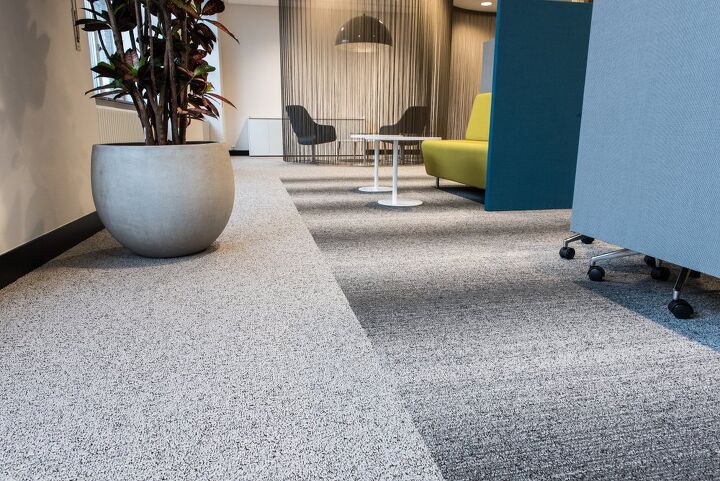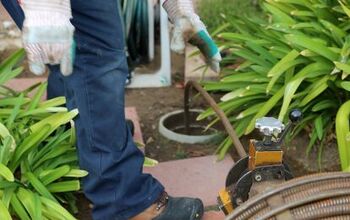How Much Does It Cost To Stretch Carpet? (Find Out Now!)

If you’ve ever noticed buckling, bubbles, ripples, wrinkles, or bunched-up spots in your carpeting, you’re not alone. These problems occur because carpet is supposed to be stretched tight. Carpet buckling is not only unsightly, but it can also quickly become a hazard to the members of your household and guests. After years of use, your carpet may require stretching in order to return it to its natural shape.
It costs an average of $60 to stretch a carpet in one room. Homeowners spend $235 to stretch all of the carpets in their house at a rate of $0.30 per square foot. It takes 1 hour to stretch a carpet, and professionals generally charge $60 per hour for labor and materials.
Though, the total price can vary based on the age of your carpet and whether or not more than one room will also require stretching. Regardless, the sooner you have the carpet replaced or stretched back into place, the better. When done correctly, carpet stretching will restore your floor covering back to its original condition.
Continue reading for our full guide on carpet stretching, including what it is, the signs that your carpet may need it, possible causes, and how much it costs.
Do You Need a Carpet Repaired, Refastened, or Stretched?
Get free, zero-commitment quotes from pro contractors near you.

What is Carpet Stretching?
If you’ve ever noticed an area in your carpeting that bubbles or ripples instead of resting perfectly flat on the floor, it will not go away on its own and will likely get worse over time. These unsightly ripples may have occurred from poor installation or heavy foot traffic over the years. This causes the carpet to lift off of the floor in clumps, which not only look unpleasant but can also lead to tripping and falling.
In this case, your carpet will benefit from carpet stretching, which is the act of physically pulling or stretching wrinkled carpet to return it back to its original shape. The process involves stretching the carpet tightly along the floor, cutting off excess, and then tacking it back in place. Carpet stretching should be done using an appropriate stretcher, as it takes a considerable amount of force to restretch carpet.
Stretching can often help carpet look good as new and if there was damage along the edges, stretching usually eliminates it. Determining whether a carpet needs to be stretched will require some observation and, oftentimes, some testing in the questionable areas.
Signs Your Carpet Needs Stretching
While there are some obvious signs that your carpet needs stretching, there are some less apparent signs that may only be visible to the eyes of a professional. Here are some indications that your carpet may need to be stretched:
Wrinkles and Lumps
If you notice visible wrinkles and lumps in your carpeting from excessive use over the years, this is a strong sign that it requires a stretching. For instance, if moving a long-standing piece of bulky furniture to a different spot in a room causes the carpet to warp in the original area, you should have your carpet stretched.
In many cases, wrinkles and lumps will form in various spots throughout the rest of the carpeting in response to foot traffic and furniture. If necessary, you can crouch down to get a closer look at the carpet. If the top looks bumpy and has a rugged surface to it, it should be stretched.
Damage
Depending on the depth of your carpet, you may have punctures or additional damage to the base structure. If the base of the carpet has damage across a large area, the surrounding carpet will come loose as a result. You should pay close attention to your carpet fibers and look out for any indications that there may be cuts to the base.
Consider using a flashlight to get a closer look into the pile of the carpet. If you find a pretty big cut, this is a good enough reason to have the carpet stretched as soon as possible before the damage gets worse. Find out 8 ways to keep a chair mat from moving on carpet.
Uplifting at the Edges
Another way to determine if your carpet needs stretching is to examine the edges. Your carpeting should be perfectly secured to the edges of the room with tack strips, which use sharp tines to keep the carpet in place. Walk around the room and inspect the edges.
If you notice any uplifting at the edges, the area should be stretched. Additionally, any carpet loosening at the tack strips will result in an overall loose carpeting.
The Awl Test
In some cases, your carpet may be hiding the fact that it requires stretching. As a solution, take an awl tool, insert it into the center of your carpet, and pull upward about an inch. Remove the awl tool and observe the movement of the carpet as it returns to the floor. If the carpet does not return quickly, it should be stretched. This test works well for carpets with deep piles, as the small hole made by the awl tool will be concealed by the fibers.
Causes for Buckled and Loose Carpet
Carpet may come loose or start to buckle for a number of reasons. The following are some of the most common causes:
- Age of the carpet. Whether you’ve been using the same carpet for a while or you just moved into a home with existing carpet, chances are that it will eventually get wrinkles. This will often happen more quickly in areas that experience heavy foot traffic.
- Poor installation. Oftentimes, this is the number one reason that a carpet has wrinkles. In some cases, your carpet may have been poorly stretched or secured improperly initially.
- Humidity and excess heat. Excessive temperatures in a space often lead to buckling and wrinkling. If the carpet was left in a very hot room prior to being installed, it will lead to bigger issues down the line. It is recommended that all carpet be acclimated to a new space at a moderate temperature.
- Heavy furniture. Moving heavy furniture across your carpet can cause the tension to loosen at the edges. Even a heavy piece of furniture sitting in one spot for an extended period of time can cause the carpet to ripple and loosen at the edges. Office chairs are often a common contributor to rippling in carpet, as the frequent movement and weight can loosen the carpet from the wall. As such, make sure you always place a thick plastic carpet protector between your carpet and the wheels of your office chair.
- Wrong carpet padding. When it comes to installing a floor covering, the padding is just as important as the carpet itself. A low-quality carpet pad or one that doesn’t pair well with the carpeting can cause the carpet to ripple or loosen over time.
- Heavy traffic. Traffic on your carpet – whether it is foot traffic, kids playing, or wheelchair activity – will cause even the most durable carpets to require stretching eventually.
- Too much moisture. In the event of excess moisture, the carpeting can separate from the backing. Whether it’s from a recent flood or a steam cleaner forcing wetness into the carpet, too much moisture can cause buckling and loosening in the carpet. In some cases, stretching is enough to resolve the issue but if the damage is too severe, you may have to replace both the backing and the carpet.
How Much Does Carpet Stretching Cost?
The cost to have your carpet stretches will depend on the age of your carpets, the extent of the damage, the size of the room, and whether one or more room’s worth of carpeting needs stretching. In most cases, you can expect to pay between $40 and $80 for a single room, or $60 an hour for carpet stretching. If all the carpet in your home requires stretching services, the average costs are between $120 and $350.
When looking for a carpet installer, make sure that you don’t just go with the cheapest quote offered. Instead, choose a company or individual based on how much experience they have and whether or not they are willing to offer a guarantee on their work. This will usually yield an end result that you’re happy with.
Do You Need a Carpet Repaired, Refastened, or Stretched?
Get free, zero-commitment quotes from pro contractors near you.

Professional or DIY Carpet Stretching – Can I Stretch Carpet Myself?
While it is technically possible to handle carpet stretching as a DIY project, it is not recommended for a multitude of reasons. For starters, it’s incredibly difficult to stretch the carpet as much on your own without professional stretching equipment. For older or more valuable carpeting, your lack of experience could result in you damaging the carpet more significantly in the process. Not to mention, you’re likely going to experience a sore back and knees from attempting to stretch your carpet.
Whereas, a carpet installer has the necessary equipment and experience to get the job done properly. When carpet stretching is needed, it is always recommended to enlist the help of a professional. In fact, those who attempt to do the carpet stretching themselves almost always end up calling the professional in the end to fix their mistakes anyways. Don’t spend more than you have to on carpet stretching and hire a professional for the job!
Related Questions
Is it worth it to stretch carpet?
In short, carpet stretching is worth it and, in most cases, absolutely necessary. Not only does it reduce the likelihood of tripping and falling over wrinkles, lumps, and uplifted carpet, it keeps your carpet looking like new, extends the carpet’s lifespan, and can even improve indoor air quality.
Do you have to remove furniture to stretch carpet?
In most cases, professionals can stretch carpet even when some furniture is still present in the room. Though, this will depend on how much furniture you have, the size and weight of your furniture, and where the damage is located on the carpet.As a general rule of thumb, to stretch carpets properly the room should be roughly 50% void of furniture. The process requires sufficient open space in a room to access the wrinkles, as well as the wall that is being stretched. When a room is filled with furniture, carpet stretching is nearly impossible.
How often should you stretch carpet?
If you have good quality carpet that was properly installed and is properly maintained, it may never need to be stretched. Though, once you start to see signs that your carpet would benefit from stretching, you can consider having it done instead of replacing the carpet.After the first initial stretching, the carpet should not be stretched more than once. If the damage reappears, this indicates it’s time completely replace all of the carpet.
How long does stretching carpet last?
When carpet is stretched properly by a skilled stretching professional, and using all the appropriate equipment, carpet stretching can easily last you 10 years – and potentially even longer.
Related Articles

Jessica considers herself a home improvement and design enthusiast. She grew up surrounded by constant home improvement projects and owes most of what she knows to helping her dad renovate her childhood home. Being a Los Angeles resident, Jessica spends a lot of her time looking for her next DIY project and sharing her love for home design.
More by Jessica Stone















![Standard Dining Room Table Dimensions [for 4, 6, 8, 10 and 12 People]](https://cdn-fastly.upgradedhome.com/media/2023/07/31/9074335/standard-dining-room-table-dimensions-for-4-6-8-10-and-12-people.jpg?size=350x220)











